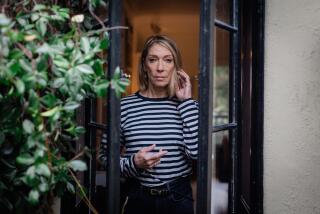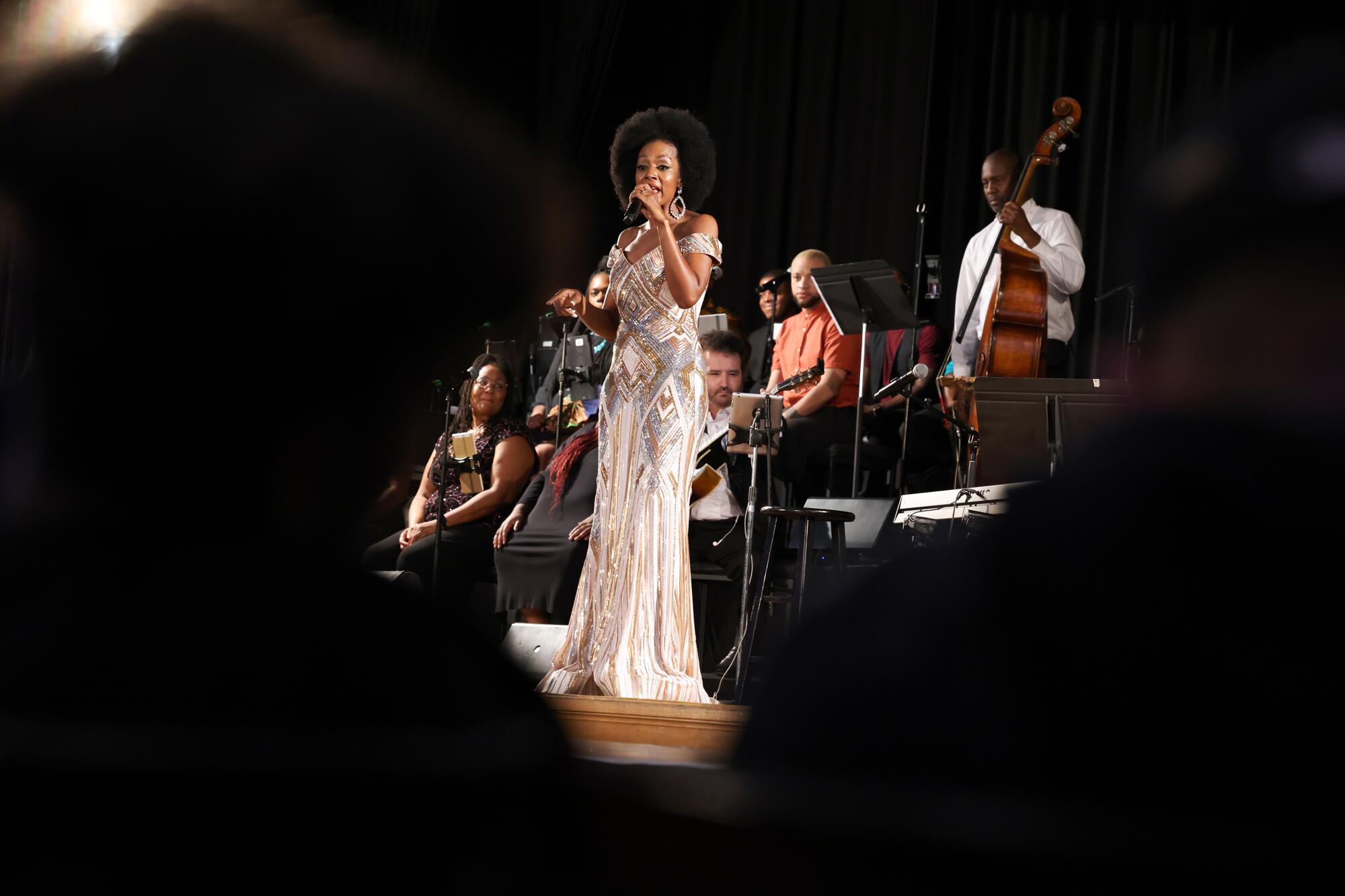
For a couple of hours Friday afternoon, Sept. 9, the clocks at Jefferson High School swept backward to an era of old-school glamour, when the 20th century was in its high-spirited adolescence, and Black folks from the Deep South were fleeing Jim Crow by the tens of thousands for the California Promised Land.
Those arrivals helped convert a multiblock stretch of South L.A.’s Central Avenue into a neighborhood where jazz giants like Dexter and Duke and Etta and Ella strolled the streets not merely as idols but as friends and regulars. Their music was celebrated and debated nightly in the Dunbar Hotel lounge and enacted as a holy rite in the Alabam Club, the Bird in the Basket and that secular temple the Lincoln Theater.
So it was that the singer and actor Sy Smith, shimmering in a floor-length gold-and-silver gown, informed an auditorium of curious, slightly awestruck teenagers that they had entered a consecrated space. She had come as part of a collaboration between Jefferson — which boasts perhaps more famous Black alums than any school west of the Mississippi — and Muse/ique, the Pasadena nonprofit dedicated to making “radically engaging live music experiences accessible for all.” The intent was to spotlight the connections between Central Avenue’s starry past and Jefferson’s illustrious heritage.
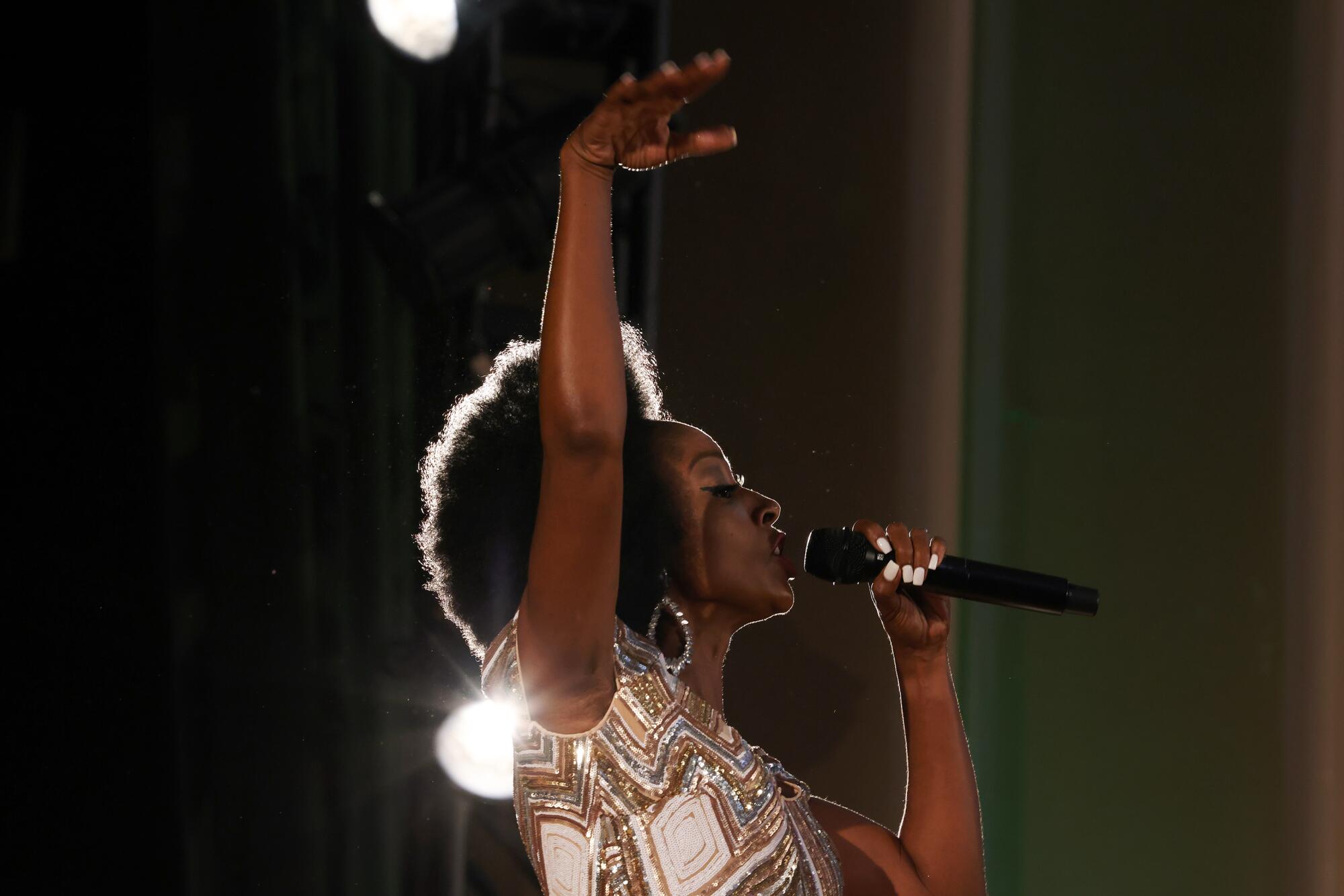
“As I stand here and perform for you, I feel like I’m performing on sacred ground,” Smith told her audience, which included Jefferson’s history-making Black principal, past and present L.A. Unified School District superintendents and fellow musicians who have worked with the likes of Whitney Houston, Stevie Wonder, Sheila E., Tupac Shakur, the Jacksons and Earth, Wind & Fire.
“And that’s a legacy of Jefferson High School,” Smith continued, “and that legacy is something they can’t take away from you, all right?”
It was a smooth segue into her next number, “They Can’t Take That Away From Me,” the Gershwins’ 1937 standard immortalized by ... well, everyone, including several artists who opened and closed shows on Central Avenue in its heyday from the 1920s to the 1950s. Smith was part of a musical ensemble that included Earth, Wind & Fire music director and pianist Myron McKinley and his quartet and vocalists LaVance Colley and the DC6 Singers collective. They were joined by members of the Lula Washington Dance Theatre.
Hosted by Rachael Worby, Muse/ique’s artistic director, conductor and founder, the musicians ripped through an hour-plus program of Fats Waller, Cab Calloway, Duke Ellington and Hoagy Carmichael classics that served both as a live-action encyclopedia entry on Central Avenue’s efflorescence and a tribute to Jefferson’s remarkable alumnae: Ralph Bunche, Alvin Ailey, Dexter Gordon, Carmen de Lavallade, Stanley Crouch, Juanita Moore, Roy Ayers, Etta James, Dorothy Dandridge, Barry White, Rickey Minor and Kerry James Marshall, just for starters.
The music jumped and juked, soared and alley-oop’d through the auditorium, named for Samuel Rodney Browne, who smashed a secondary-school color barrier when he became Jefferson’s music teacher in 1936.

“This is the Hogwarts of music,” McKinley told the students during the lead-in to “Sweet Georgia Brown.” “So get your wand and start doing all that stuff, because the people that came out of here changed the music industry.”
Among those nodding along was Tamai Johnson, the first Black female principal in the history of the school, founded in 1916. Growing up in nearby Lynwood, Johnson knew practically nothing about the bygone Central Avenue scene. But she was learning a lot.
“Almost a full semester of history in one concert, right?” she said. “I think I have an obligation to really just expose the students to partnerships like this that will spark an interest in the arts and in learning outside of the classroom.”
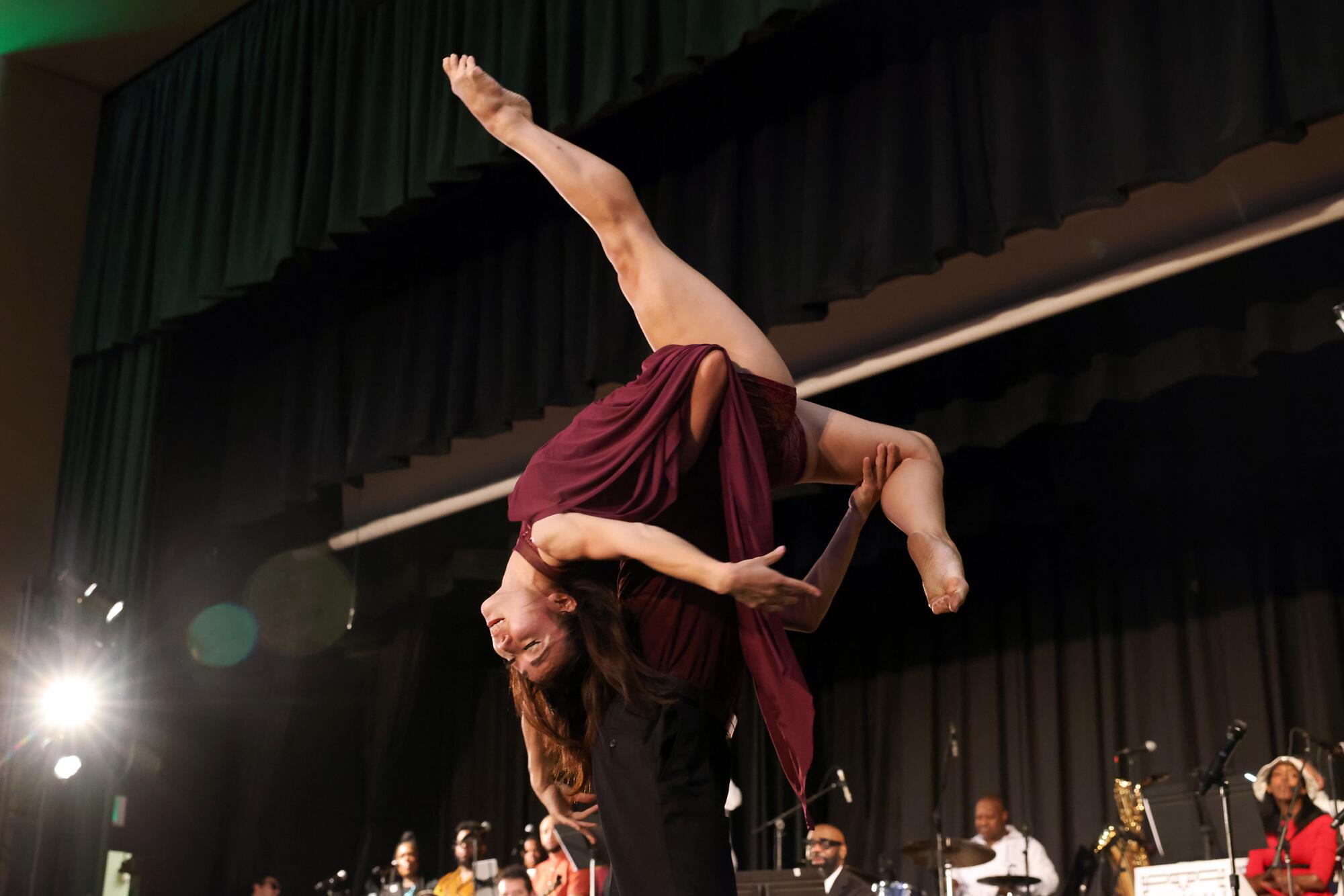
Although the members of the class of 2023 may be as likely to hail from Zacatecas, San Salvador, Tegucigalpa or Guatemala City as from Louisiana or Texarkana, Johnson predicted that Friday’s program would translate easily, because “culture is more than just race.”
McKinley, the music director and pianist, who was raised at 64th Street and Cimarron, said he too knew “very little” about Central Avenue’s glittering history and its alliance with Jefferson High. Then, three months ago, he connected with Worby of Muse/ique, who began filling him in.
“I couldn’t believe that that was such an influential place that we never knew about in our generation,” McKinley said. “And for us to not know that and not celebrate it and have it continue, it really hurt my heart. So I was really invested to be a part of this.”
Worby, a Leonard Bernstein protegee, conceived and curated the concert as part of “A Season of Streets,” Muse/ique’s on-site performance series inspired by L.A. landmarks such as Sunset Boulevard, Laurel Canyon, Whittier Boulevard and Hollywood and Vine, using music to knit together a fragmented metropolis.
She approached her friend Austin Beutner, the well-connected former investment banker, deputy mayor, Los Angeles Times publisher and LAUSD superintendent, who put her in touch with Johnson. Beutner spoke briefly before Friday’s performance and put in a plug for Proposition 28, on the ballot this fall, which would provide new funding for K-12 public school arts and music education.
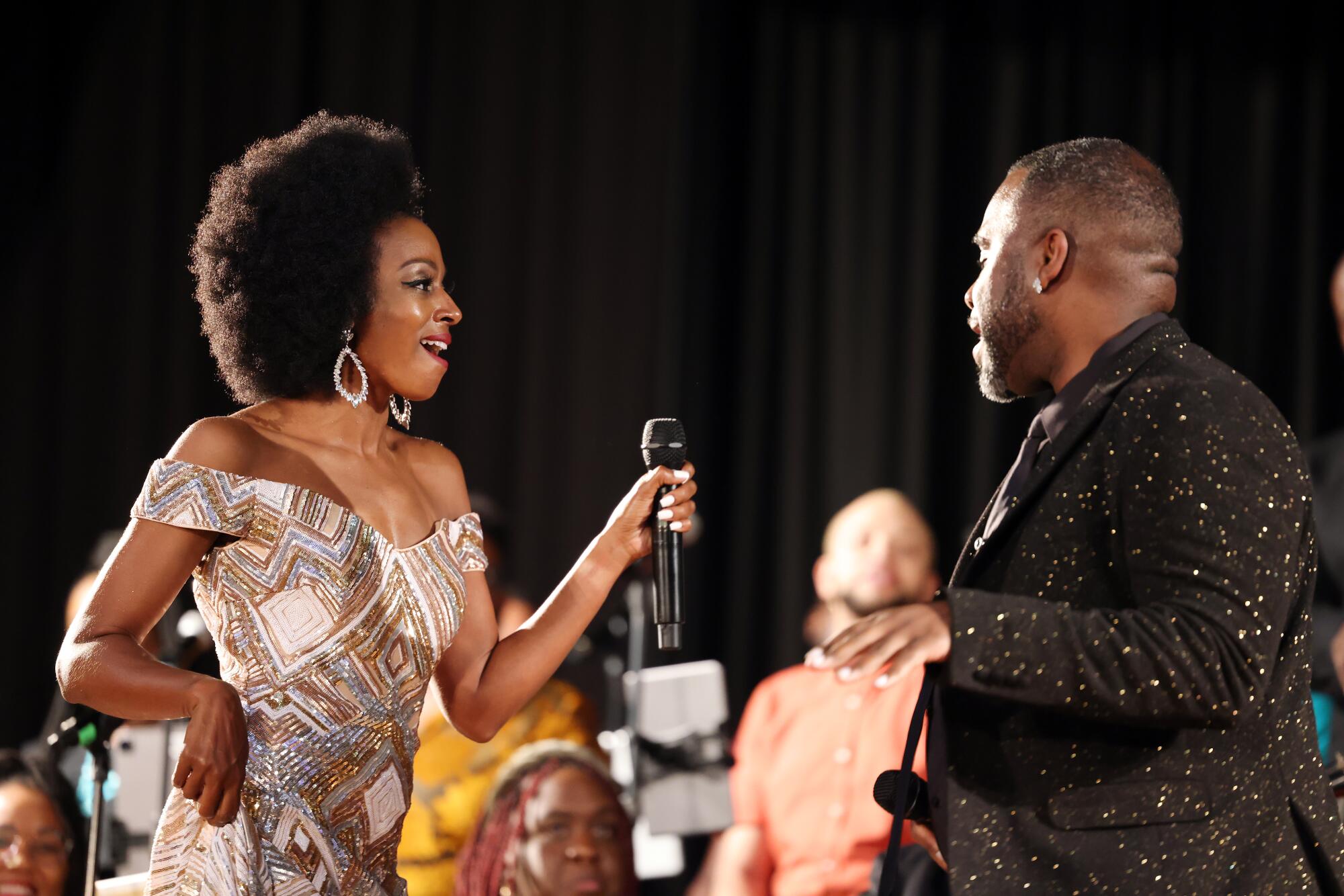
So did current Supt. Alberto Carvalho, who’d spent the week grappling with a crippling systemwide hacking incident and new test scores showing that 72% of LAUSD math students and 58% of English students don’t meet state standards.
“In my world, democracy and America are one and the same, jazz and America are one and the same, which means jazz is a form of democracy,” Carvalho told the students.
Another guest was multi-instrumentalist and composer Dexter Story, whose father went to Jefferson and named his son after Dexter Gordon.
“I was a knucklehead. I was like, ‘Why is he always telling me about Central Avenue?’ It wasn’t until I got older that I realized how much heritage there was,” said Story, who described Muse/ique’s concert series as a form of mobile “social justice.”
After the concert, students traded impressions.
“It was pretty magical,” said Rafael Rosas. “You usually don’t see this stuff in real life. It’s usually on TV.”
“This educated me so much,” Daniela Medina said. “I had no idea that this many people went to this school and graduated and had these amazing careers.”
The students wondered if such events could happen more often. They also hoped that more kids would join the school band, or color guard. That will be challenging: Hector Artero, who plays in the group, said he had the school’s only working alto saxophone.
“Most of the equipment that we have is old and really run-down,” he said.
With so many problems besetting LAUSD students — poverty, declining test scores, COVID aftershocks, beleaguered parents — music and art can seem like luxuries. The glory that was Central Avenue can seem like a dream.
Worby vows to return to Jefferson soon.
“I don’t believe in drive-by education, and so we’ll be back next year and the year after that. We’re not going to make going to Jefferson some great cri de coeur that doesn’t resonate into the future. That just doesn’t work.
“Something about those walls and hallways might breathe possibility,” she added.
As the last notes of “When the Saints Go Marching In” dissolved, the monstrous heat wave that had clutched the city for days began to crack. Scattered raindrops fell on the students as they emptied out of their fame-haunted school.
More to Read
Start your day right
Sign up for Essential California for news, features and recommendations from the L.A. Times and beyond in your inbox six days a week.
You may occasionally receive promotional content from the Los Angeles Times.

